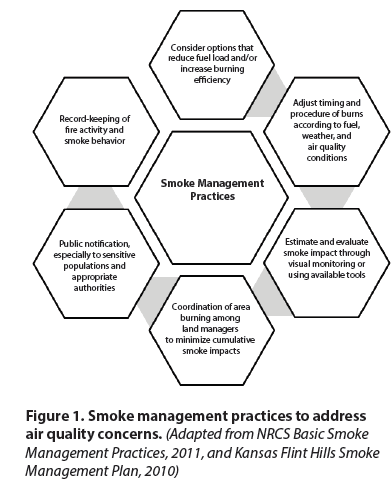Module 6: Smoke plan
Burn planning and preparation
Module Objective: What is a Smoke Management Plan and why do you need one?
What is a Smoke Management Plan?
Outdoor burning can be a nuisance for neighbors and add to air pollution caused by other sources (such as home heating). No matter what the fire season is, you still need to comply with any council bylaws and regional council requirements relating to smoke nuisance and discharges to the air even if you are issued with a fire permit for FENZ.
A smoke management plan is a document to help you reduce the impacts of smoke on sensitive areas during your burn.
Why do you need one?
Smoke generated from a burn may create a hazard or nuisance, and it may be subjected to legal requirements when planning any burn.
Potential smoke hazards may include:
- Road and transport safety
- Public healthy (especially people with respiratory conditions)
Smoke impacting on roads is a significant safety hazard. Several fatalities have occurred because of smoke causing traffic accidents. This can result from thick smoke drifting across roads and cars colliding. Another way is from overnight inversions during stable weather that causes smoke to settle over roads and reduce visibility.
How can you manage smoke hazards
Examples include but are not limited to:
a. Choosing a day to burn when neighbours are away or not likely to be effected;
b. Burning when wind is blowing away from effected people or sensitive activities;
c. Locating the fire in a remote area, or at a suitable distance from sensitive activities;
d. Having machinery available to keep the fire burning hot, or extinguish it if necessary;
e. Preparing the fire so that the material will burn fast and hot and not slowly smoulder;
f. Notifying neighbours that you are going to burn; notifying the New Zealand Fire Service before the burn;
g. Having traffic management in place if the burn causes reduced visibility on roads; not burning in cool calm conditions as smoke is unlikely to disperse.
Traffic control plans could be required when there is a chance of smoke impacting nearby roads identified in your burn plan. Wind direction requirements will be important weather component of your burn plan to reduce this hazard.
Avoiding air quality problems.
- Conduct prescribed burns when weather patterns are favorable for dispersion.
- Then smoke is carried away from sensitive areas that were identified as part of the prescribed burn planning process.
- Weather components such as wind speed and direction, mixing height, transport winds, inversions, humidity, and atmospheric stability can affect the direction and distance smoke travels and how close to the ground it remains.
- Use weather predictions to determine optimal times to burn to avoid producing smoke that will affect sensitive areas. When available, use modeling predictions that indicate where smoke plumes will travel.
- Avoid burning when the plume is directed toward urban areas.
- When smoke has the potential to drift over sensitive areas and burning cannot be delayed, notify health authorities in advance so air quality alerts can be distributed and people notified to take action, such as staying inside, to avoid breathing the smoke.
Diluting the effects of smoke production.
- Scheduling burning activities so large quantities of smoke are not produced from the combined emissions from many fires.
- Coordinate burning activities across the air shed to spread them across a larger time frame to maintain air quality at attainment levels in sensitive areas.
Reducing emissions.
- Use fuel management to produce less smoke. Reduce the quantity of fuel burned and increase fuel combustion efficiency.
- Less smoke is generated when fewer acres are burned if fuel loads are equivalent. Burn only when a specific management objective requires it.
- Fuel loads are also reduced when burning occurs at frequent intervals, reducing fuel buildup, especially of woody species. Livestock or wildlife grazing decreases fuel loads, but range managers should be certain that enough fuel remains to carry the fire and meet management objectives.

What is in a smoke management plan?
- Dates of the intended burn - the dates may change if conditions are not favourable on the intended dates.
- Type of material to be burnt - is it standing crop residue, shelter belt clippings, stumps, entire hedges, forestry debris; paper, cardboard or untreated timber.
- Forecast windspeed and direction for the actual duration of the fire. Ideally windspeed will be between 1 and 15km per hour. For burns planned to take place over a timeframe of more than three days, the smoke management plan will identify prevailing wind conditions for the time of year.
- Condition of the material to be burnt - for example: is it green or seasoned; wet or dry; is the material large solid pieces such as tree stumps or smaller loose material such as branches or a combination?
- Identification of potentially affected parties and sensitive activities - include neighbours living close enough to be affected, Transit New Zealand if the burn is close to a state highway, FENZ if it is likely the public will call to raise concerns about the fire.
- The methods for minimising impacts on people effected
Self-Check: Think about a burn you have conducted in the past; did you consider the above points? Reflect on how these points may have helped assist you with previous burn experiences.
Activity Complete a Smoke Management Plan for your planned burn.
(Link for Ecan smoke plan)
(Link for FAR smoke plan)
Learning outcome:
You should now be familiar with the elements of a smoke management plan to conduct a prescribed burn.
